#polish cuisine
Text

Heart-Shaped Polish Pączki with Raspberry Filling (recipe in Polish)
#pączki#raspberry#polish food#easy recipes#heart shaped#filled donut#donuts#foodblr#polish cuisine#food#poland#sweet tooth#lovecore#valentines day#heartcore#paczki#sweetcore#happy valentine's day#dessert#doughnuts#walentynki
3K notes
·
View notes
Text


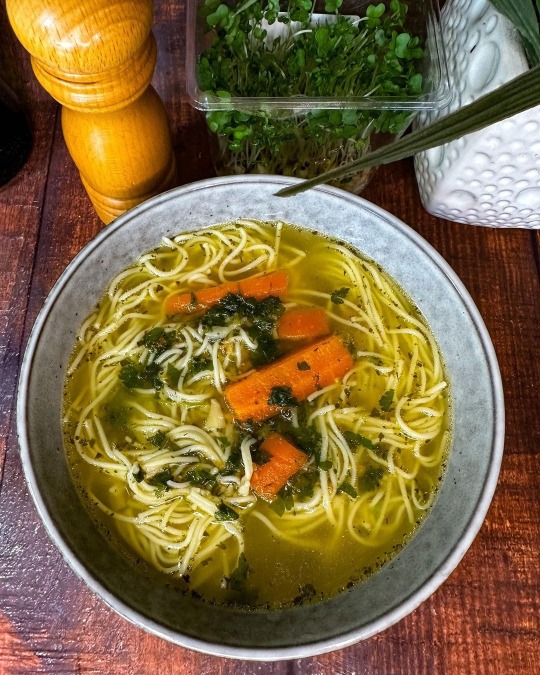

ROSÓŁ APPRECIATION POST 💛
Rosół is a traditional Polish meat broth.
#rosół#polish cuisine#meat soup#poland#polish food#rosol#polska#meat broth#meat#soup#chicken soup#żołądki#broth#polish culture#traditional food#food#grandmacore#polishcore#vegetables#carrots#*
1K notes
·
View notes
Text
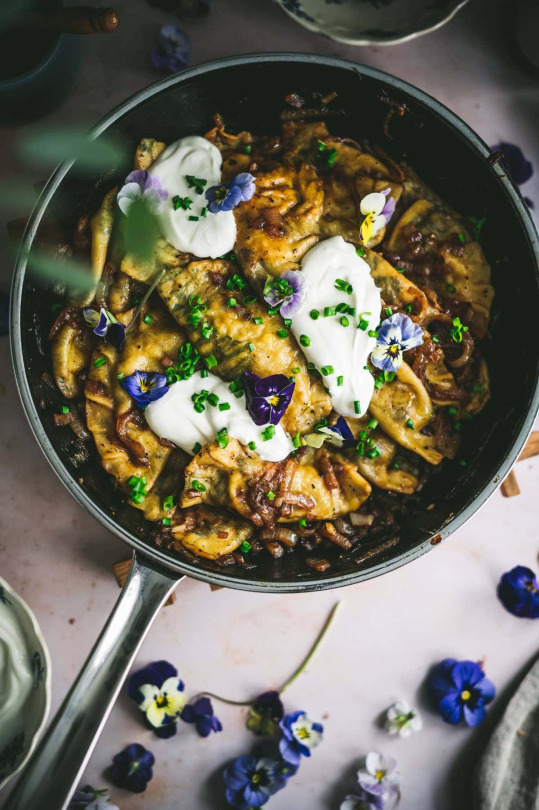

Potato Pierogi with Edible Flowers (Vegan-Friendly)
#vegan#appetizer#lunch#polish cuisine#Central European cuisine#dumplings#pierogi#diy#violets#pansies#edible flowers#potato#plant milk#vegan yogurt#chives#onion#olive oil#black pepper#sea salt
28 notes
·
View notes
Text
In relation to my last post about Ukrainian and Polish gingerbread cakes I would like to make a little poll:

#poland#ukraine#food#polls#tumblr polls#cake#bakery#baking#ukrainian cuisine#polish cuisine#traditional food#christmas#christmas food
46 notes
·
View notes
Text

Happy Fat Thursday to all who celebrate. It's the day get your pączki up.


I was supposed to draw faworki too. But I'm just one girl and that's a lot of food...
#art#my posts#drawing#anime art#digital art#painting#food drawing#food art#food#polish cuisine#polish food#donut#pączki#Fat Thursday#tłusty czwartek
28 notes
·
View notes
Text
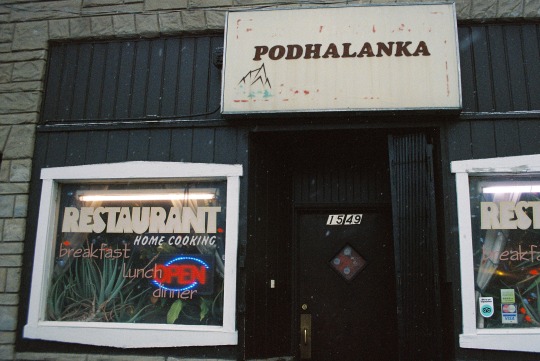
Polish Triangle
Chicago, Illinois
#illinois#35mm#analogue#film photography#original photography#photographers on tumblr#Chicago#polish triangle#little poland#podhalanka#city photography#street photography#polish food#polish cuisine
12 notes
·
View notes
Text
Pierogi & Kielbasa Curry
This is a Polish-Indian fusion dish that is one of my favorite meals to make. The Gujarati spice base with Polish staples makes for a very tasty and hearty stew-like curry. Enjoy :)
NB: If an ingredient doesn't have an amount next to it, it is intended to be eyeballed to the maker's preference. Additionally, be sure to check the footnotes at the bottom before asking any questions. My inbox is always open.

Ingredients
Vaghar
Vegetable Oil
1 Cinnamon stick
5-10 Cloves
Cumin seeds
Black mustard seeds
Fenugreek seeds
1 Dash of hing (asafoetida) (1)
Contents
1 Onion
Garlic (2)
12 Potato & Farmer's Cheese Pierogi (3)
1 Kielbasa (14 oz.) (4)
2 Tomatos
Water
~1 tsp. Tomato paste
Spices and Thickeners
Cumin powder
Coriander powder
Paprika
Garam masala (5)
Chili powder (6)
~1 cup Sour cream (7)
Potato Flakes
Instructions
Start by mincing the garlic and dicing the onions and tomatos. Then Put them to the side. To make the vaghar, put the vegetable oil in a large pot over medium heat. After about a minute of letting it heat up, add all of the whole spices to the pot (cinnamon, cloves, cumin seeds, mustard seeds, and fenugreek seeds). Stir the spices a little to make sure they are coated in the oil. Once the cumin seeds begin to toast and change color, add the hing and stir again. The goal here is to infuse the oil with the flavor of the spices, so once you feel that has been accomplished(8), add the garlic and onions and begin sauteing(9).
Once the onions start to brown, add the kielbasa and all of the pierogi. Be sure to stir carefully so as to not poke holes in the pierogi, and make sure there is enough oil to prevent the pierogi from sticking and tearing open. If you notice things starting to stick, add more vegetable oil. Ultimately, the goal at this stage is to fry the pierogi skins to prevent them from becoming soggy after you add the water and infuse the pierogi and kielbasa with the flavor of the spices. Once you feel that is done, add the diced tomatos (juice and all) to the pot, and fill with water until everything is covered. add the tomato paste and stir.
Add all of the ground spices (cumin, coriander, paprika, and garam masala, and chili powder(10)) and stir. Turn the stove up to high, and stir. Continue to stir carefully so as to avoid tearing pierogi, and try diligently to keep things off the bottom of the pot because they will stick easily. Once the curry starts to boil, turn the heat down to low/simmer and add the sour cream. Once you are happy with the amount of sour cream you have added, thicken the curry the rest of the way to your preference with the potato flakes.
Footnotes
Ingredients
(1) If you cannot obtain the hing or garam masala, don't sweat it. They are not integral parts of the recipe.
(2) Feel free to economize anything in this recipe. I frequently use garlic powder instead of garlic and canned diced tomatos when I am busy. The recipe above in its current form is intended to represent the freshest possible version of it. Do not drive yourself crazy trying to make it perfect.
(3) Be careful with pierogi that simply call themselves "potato and cheese." I know at least in the United States a lot of the potato and cheese pierogi use cheddar, which would not work for this recipe. Alternatively, you could use plain potato pierogi and make the farmer's cheese yourself (to my knowledge all you have to do is boil milk, add sour cream till it curdles, and strain the curds) and add it seperately to the curry.
(4) Preferably, use turkey or chicken kielbasa to avoid accidentally committing a heresy against one of the two cultures this dish is from.
(5) Generally, its highly unusual for turmeric to be lacking from the list of spices in a curry like this, but in my earliest attempts with this recipe, I noticed it was clashing with the spices usually found in kielbasa. If you want to try adding it anyways, be my guest.
(6) I actually usually don't add chili powder since this curry is already naturally so mild I most often make it for spice-averse audiences, but hypothetically just chili powder shouldn't really increase the heat much because of all the dairy. Therefore, if you're interested in making this recipe with all the heat of a traditional indian curry, I recommend adding a few whole, dried red chilis to the vaghar as well as a tablespoon of chili garlic sauce when you start cooking the onions.
(7) 1 cup is what i most commonly add, but really how much you want to add is entirely dependent on how much you like sour cream. You could easily put in 2 cups as well. You could also put in 1/2 a cup and and have sour cream available for people to add to their individual bowls.
Instructions
(8) the other goal here is to not burn the spices. It can be a fine line trying to infuse as much of their flavor as possible into the oil without overheating them. All you can do is try to gauge if its infused by smell. Ultimately, if the scent of the vaghar becomes smoky, just add the onions immediately to prevent any further burning.
(9) I also like to add a small amount of all the ground spices (cumin, coriander, paprika, and garam masala) or a teaspoon of curry paste to the onions here as well. This helps give the onions, kielbasa and pierogi more of that flavor, but it also absorbs oil and makes things easier to stick the bottom of the pot, so judge for yourself whether its worth it.
(10) see 6. It is not necessary to add the chili powder unless you like heat.
24 notes
·
View notes
Text
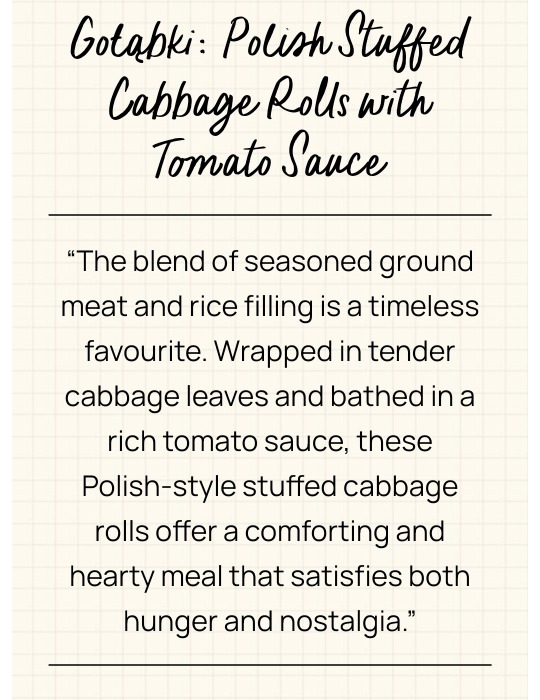

gołąbki my beloved...
the english pronunciation is `go-whomp-keeʼ (some say `golumpkiʼ) and the literal translation is `little dovesʼ— !!
♡ find the recipe HERE ♡
#soooooo good#simple hearty dishes are always the best#gołąbki#polska żywność#polish food#polish cuisine#polish recipes#recipes#food#tw food#golumpki#gowompki
14 notes
·
View notes
Note
Like This Post If you are polish
.
#polish#poland#polishblr#polish culture#polish cuisine#polish art#polish tumblr#likes#askboxlikes#mychemicalparagraph
7 notes
·
View notes
Text
Fat Thursday / Tłusty Czwartek in Poland

Pączki z lukrem i skórką pomarańczową (doughnuts with sugar icing and orange zest) - [photo Anna Rezulak/KFP (fragment) on citation right]
Today is Fat Thursday and I would be surprised not seeing the doughnut posts from Polish community flooding the internet. So here’s some vocab and ideas of what you can eat for Fat Thursday in Poland.
Tłusty Czwartek – Fat Thursday
Pączek (pączki in plural) - doughnut, but without a hole. Generally this is a symbol of Fat Thursday to a such an extend, that even your employer will treat you with one or two doughnuts this day. They may or not not have an icing / icing sugar on tom, and they mostly do have a filling of rose marmalade.
Donat (donaty in plural) – obviously the word is a polonized word “donut”. It describes only these american donuts with a hole in them and heavy colorful icing and toppings (pączki have more traditional modest icing & toppings)
Faworki (already in plural) / chrust (singular, uncountable)– angel wings. In some regions it is called faworki, and in some – chrust. Chrust exactly mean “brush, brushwood”
Oponki serowe (already in plural) – crude cheese / cream cheese donuts (cheese being mixed with the dought). These are definitely with the hole, because oponka (in singular) – means “small tyre”.
#poland#fat thursday#tłusty czwartek#pączki#donuts#polish food#polish customs#polish language#polish cuisine#polska#langbr
12 notes
·
View notes
Text

Polish Butter Babka (recipe in Polish)
#babka#babka maślana#butter pound cake#easter food#polish easter#polish food#poland#polish cuisine#food#foodblr#pound cake#dessert#sweet tooth#baking#easter#happy easter#pink aesthetic#pinkcore#pink food#bundt cake
88 notes
·
View notes
Text


pączki - Polish doughnuts 🤎🤍
#happy fat thursday#fat thursday#pączki#tłusty czwartek#poland#polish food#polish cuisine#tlusty czwartek#filled donuts#doughnuts#donuts#polska#polishcore#powdered sugar#pastry#icing sugar#foodlover#food aesthetic#foodie#pretty food
735 notes
·
View notes
Text
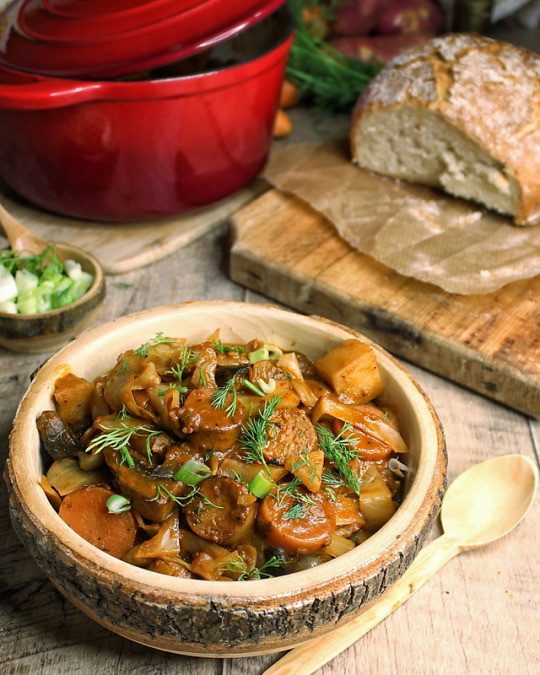
Vegan Bigos (Polish Hunter's Stew)
#vegan#lunch#dinner#polish cuisine#Central European cuisine#stews#veganized#bigos#mushrooms#potato#carrots#vegan sausage#apples#cabbage#sauerkraut#tomatoes#onion#garlic#paprika#marjoram#caraway seeds#worcestershire sauce#molasses#nutmeg#black pepper#wine#sea salt
22 notes
·
View notes
Text
i love how the world is discovering kopytka and kluski śląskie and is now calling them "potato noodles". truly fascinating
#i do like the recipes with like spicy sauces and stuff they do be good#kitchen#shitpost#poland#polish cuisine#cuisine#noodles#kopytka<33#slavic
8 notes
·
View notes
Text

"Gołąbki"
We always make them for all saints day
44 notes
·
View notes
Text
Polish Versus Ukrainian Cuisine, Part 1
I have to confess, I have a little sin on my consciousness, namely, I visit Instagram sometimes. In most cases I do that just to catch up with my friends and family, but, you know, as most of young people of my age I just end up scrolling a tiny bit (usually, right until the moment I feel the urge to vomit, as I genuinely hate this place).
Recently, I came across a very cozy video where a Korean home cook mixes a Polish Pierogi Ruskie recipe with some Korean toppings. The thing that confused me the most, though, was the most liked comment under this video left by a Ukrainian woman who claimed that Pierogi Ruskie is a Ukrainian dish and is, in fact, called Varenyky. It's easy to assume that this person has never made a single dumpling, varenyk or pieróg in her entire life, as she kept on claiming that Pierogi Ruskie can have a lot of different fillings and that Polish Pierogi don't have such a big choice of fillings as Ukrainian Varenyky do, so, clearly, this person had zero idea what Pierogi Ruskie actually are, but that's not the point.
This comment made me wonder how different are the two cuisines of those Eastern European countries. Having lived long years in both countries, I thought it would be interesting to study this topic a little bit, namely from the perspective of the difference between the staple dishes in two cuisines. After all, we actually are what we eat, especially on the global scale. Everyone knows Italy for their brilliant pizza and pasta, and everyone knows Japan for sushi and tempura, and even though food is not the only aspect of those cultures that made them famous around the world, it definitely adds up to create a full picture of their collective cultural identity.
So, in this post I'd like to share some personal observations that I made throughout my life about Polish and Ukrainian cuisine having lived significant portions of life in both countries, being ethnically related to both and being wholeheartedly fascinated by food.
Disclaimer!!! I'm not a food scientist or chef, nor am I a professional historian. All the notes down here are mostly based on my personal observations and some basic research. I did consult a professional cook and a baker whom I know personally as they happen to be my family members. I do recommend treating everything I share here with a grain of salt (hehe, because we gonna talk 'bout cookin', hehe, so use salt) and bear in mind that different cooks have different approaches to their recipes and your personal experience with Ukrainian and Polish food might differ from mine. That being said, I encourage you to share these experiences whether you are Ukrainian, Polish or anyone else, really. I do not accept such arguments as "Ruskie because Kyiv Rus!", though, as it's not about arguing in the first place, it's about diving into the heritage of those two countries and talking about the food.
Pierogi vs. Вареники

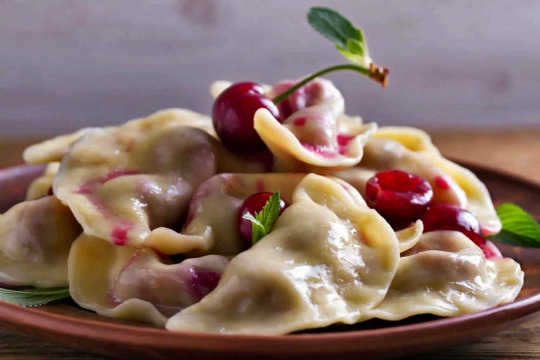
Let's start with them culprits. I think those two dishes are the most confusing ones because of their similarity. Gosh, both of them are dumplings from Eastern Europe shaped like a growing moon, aren't they?
The dough for both dishes varies from region to region, from cook to cook. In my experience, both recipes need three basic ingredients:
- liquid
- salt
- flour
The rest depends, really. You can change the four, you can change the liquid, replacing water with milk or kefir, you can add an egg. I personally go with my mother's recipe which is boiling hot water, egg, AP flour and salt.
Two of the striking differences are their size and shape. It seems like Ukrainian dumplings are usually smaller, flatter and quite translucent in comparison to Polish ones, which are big, sometimes even huge (check Pierogi Po Bieszczadzku, they are bigger than my fists, I kid you not), they have a very full body and the dough itself is thicker (the reason is not so much ingredients in the dough as is the method of forming/cutting the circles out of it). They also have a lot of different really funny regional names which very often also refer to the size, shape, filling or method of preparation, for instance, Dzyndzałki (Warmian small dumplings served in soup), Bulwanki (Eastern Polish holiday pierogi with variety of savoury fillings), Sasznie (A type of dumplings from Eastern Borderlands that use potato in the dough) or Sójki (Masovian baked pierogi made with yeast).
The fillings of both Pierogi and Varenyky basically might create their own multiverse. In both Poland and Ukraine, I found so many different combinations of fillings that it would be a waste of time to write about each one of them. However, Pierogi most often have savoury fillings (from meat through cheese and potatoes though different types of groats and the list goes on and on..), while Varenyky have a bigger variety of sweet fillings, including the classic cherry filling. Also, Ukrainians seem to be not very much into the meat filling. In my childhood, I had never eaten meat dumplings in Ukraine, however, at the time, pelmeni were quite a popular alternative. Ah, classic Soviet influence - replace your own with something russian )yuck.
As for the toppings, depending on what kind of filling you are dealing with, there are many alternatives for both dishes, including chives, fried bacon, sour cream, melted butter, caramel sauce (haven't seen this one in Ukraine, but noticed it being popular in Poland with sweet cottage cheese Pierogi) and many others. Both dishes are absolutely marvelous even without any additions.
Now, if anyone says that Pierogi Ruskie are called that way because they are Ukrainian, they are not entirely wrong. This type of pierogi was invented in Eastern Galicia (a geographical region in Western Ukraine which was also used to refer to the Eastern part of Poland; The name derives from its Polish name of territory - "Ruś Czerwona" ("Ruthenia Rubra" in Latin)), however there's a high chance it happened when it was the part of Austrian Empire, when majority of population in this region, especially in big cities including Lviv, were Polish. Either way, this dish is much more popular in modern Poland and has lots of different regional variations that you can meet across the whole country (see the Bryndzylki designed by Polish Highlanders), while it's basically non-existent in Ukraine and in the country they are often called "польські пироги" (literally "Polish Pierogi". Pierogi Ruskie are prepared with cheese, onion and potato filling, while in Ukraine you are more likely to come across some Varenyky with potato, onion and bacon filling.
Thank you very much for your attention, share your dumpling preferences and experiences in the comments or in the reblogs, share your recipes, go crazy, and let's discuss the food!!
My pierogi variation with cottage cheese and strawberry jam filling (not the most attractively shaped one, but very tasty - my significant other approved them):
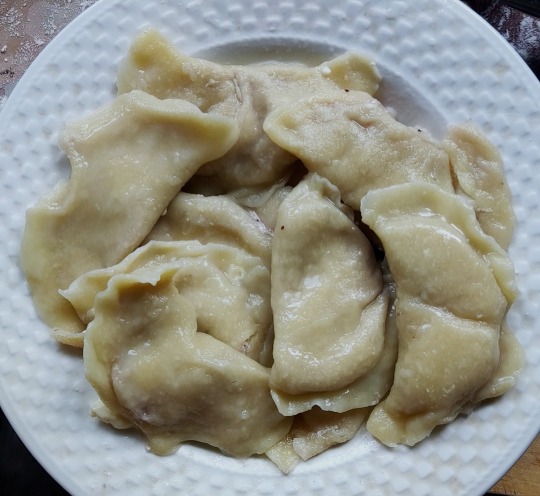
#poland#ukraine#pierogi#varenyky#polish cuisine#ukrainian cuisine#polish culture#ukrainian culture#dumplings#cultural differences#culturalheritage#culturalexploration#polska#polska tradycja#polish tumblr
8 notes
·
View notes